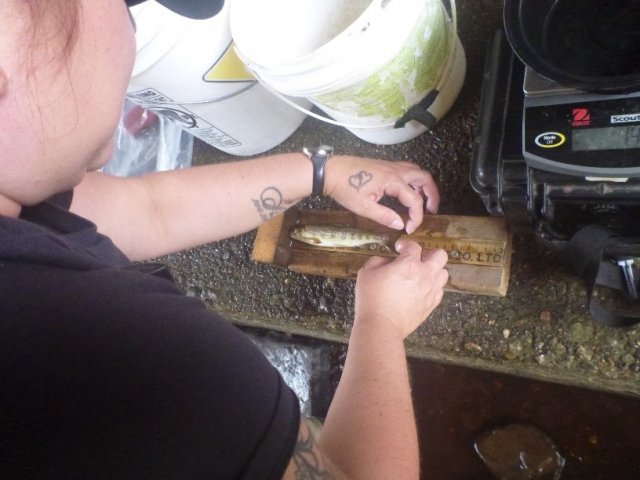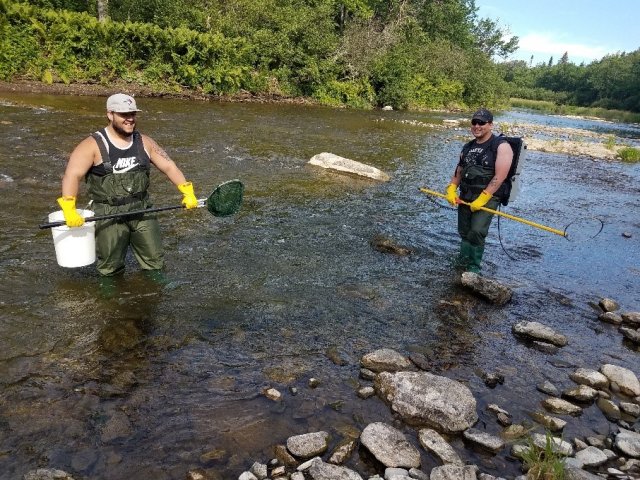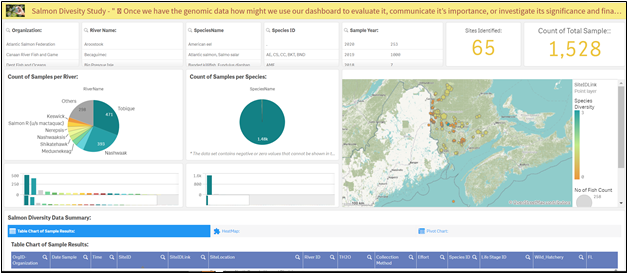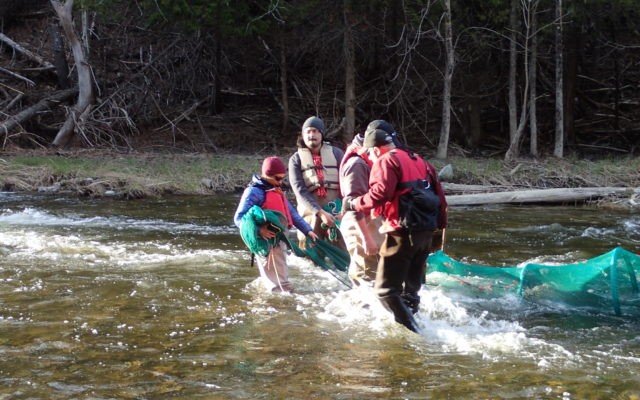Native American tribes in Maine have traditionally fished migrating and resident fish species, including Atlantic salmon, as a key part of their diet. However, over time, these traditional practices have been negatively impacted by industrial development which has caused decreasing water quality, loss of fish habitat, and obstacles to fish migration pathways. Additionally, interbreeding wild Atlantic salmon with less genetically-diverse domesticated and farm-raised salmon has caused reduced fitness and adaptability of wild Atlantic salmon. The decline, and in some cases the elimination, of these important fish populations has meant the loss of a central component of tribes’ traditional diet.
Atlantic salmon are culturally significant to the Maliseet people whose ancestors have fished and lived along the St. John River (or Wolastoq in the Maliseet language) for thousands of years. The Meduxnekeag River is an important tributary in the St. John River Watershed that begins at the Meduxnekeag Lake in northern Maine and joins with the St. John River near Woodstock, New Brunswick Canada. The Meduxnekeag River runs adjacent to the Houlton Band of Maliseet Indians (HBMI) Trust Lands and is a vital tribal resource. One of the primary missions of the HBMI is to restore Atlantic salmon to the Meduxnekeag River.

Sharri Venno, an environmental planner for the HBMI, describes the importance of the Atlantic salmon, “The loss of Atlantic salmon and other sea run fish to the Houlton Band of Maliseet Indians – from the damming of the Meduxnekeag River in the 1800’s, the construction of Mactaquac Dam on the Wolastoq/St John in 1968, to the ongoing impacts of climate change- has represented an ever-increasing loss of sustenance, of traditional practices, and of spiritual ceremonies. Ultimately it is a cultural loss of relationship between the tribal community and sea run fish that I can’t put into words. Restoring that relationship through the return of these fish to tribal waters will be of immeasurable value to the Tribe and their efforts to sustain the health and welfare of our community and cultural lifeways.”
The HBMI has taken significant steps towards the restoration of salmon in the watershed, including conducting water quality monitoring, restoring aquatic habitats and ecosystems, and partnering with EPA and other federal agencies to perform fish habitat assessments. In 2018, the HBMI conducted an environmental DNA (eDNA) presence/absence study of salmon within the watershed. Results confirmed the presence of Atlantic salmon occurred only on the Canadian tributaries of the Meduxnekeag River, underscoring the importance of continued restoration efforts.
EPA researchers are working in collaboration with the HBMI, as well as with the Maliseet First Nations in Canada, to help restore and reclaim their heritage of a thriving Atlantic salmon fishery in the St. John River Watershed and the Meduxnekeag River. By leveraging knowledge from key Atlantic salmon researchers and genetic experts who are working as partners on the project, the HBMI can gain valuable information and resources on the Atlantic salmon population in the Meduxnekeag River and avoid expensive and time-consuming hit-or-miss trial-and-error breeding efforts.
On EPA’s role in this collaborative research effort, Deb Szaro, EPA Acting Regional Administrator for Region 1, says “By initiating and facilitating this research project, EPA plays a pivotal role in the restoration of Atlantic salmon in the St. John River and furthers the efforts of the cross-boundary Wolastoq watershed restoration collaboration by convening tribal, federal, state and international partners to construct a genetic diversity mapping of salmon within the river system.”

To enable more effective Atlantic salmon preservation and restoration efforts by tribal, state, federal, and international partners, EPA is collaborating closely with the HBMI, the Maliseet Nation Conservation Council, US Fish and Wildlife Service, the National Oceanographic and Atmospheric Administration, Division of Fisheries and Oceans – Canada, and the University of New Brunswick, to create a cloud-based Population Diversity Database. The Population Diversity Database housing the data of genetic analysis of fish tissue samples will be used to establish routine genetic assessment of Atlantic salmon tissue and provide key information on natural diversity.
Establishing this database of genomic information on salmon in the watershed creates the ability to consistently choose the genetic strain of salmon that has the greatest chance of survival and the closest genetics to current Atlantic salmon populations present in the Canadian side of the Meduxnekeag River while promoting the genetic diversity necessary to re-establish and maintain the native salmon population. The data will provide valuable information for live gene banking, captive rearing, and release of salmon into tributaries with limited or nonexistent salmon populations. Using the genomic information in the Population Diversity Database, the HBMI will be able to reliably select tributary-specific salmon to restore to the Meduxnekeag River.
As of August 2021, the project has collected over 1500 Atlantic salmon tissue samples from 65 distinct sites in 21 separate rivers and streams in the St. John River watershed. Another 90 samples are planned for collection in the first quarter of 2022 from three distinct populations managed at the Department of Fisheries and Ocean’s two biodiversity facilities in Mactaquac, New Brunswick, and the Coldbrook, Nova Scotia. In the spring of 2022, the project team will process nearly 1,000 samples specifically selected for genomic analysis of microsatellites at EPA’s Office of Research and Development laboratory in Cincinnati, Ohio.
Additionally, another EPA project is currently underway to supplement the ongoing work of our project partners. The focus of the project is science communication as it relates to Atlantic salmon genomics and will consist of the creation of a method walk-through which aims to communicate the science, purpose, effectiveness, and implications of the genomic analyses performed by EPA’s ORD laboratory in Cincinnati, Ohio. Another goal of the project is the publication of an ArcGIS StoryMap to serve as a collaborative communication tool that offers both visualization and narrative descriptions of the whole of our research effort from Atlantic salmon sampling, DNA extraction, genomic analyses, and the eventual creation of the Population Diversity Database.
The database will be made available for display, exploration, and use by the project team on a dashboard created and managed by EPA Region 1 Geographic Information Systems (GIS) Office. Use of the dashboard will help to advance research efforts to increase biodiversity and continue restoration throughout the entire St. John River watershed and others along the Atlantic coast.
In addition to informing ongoing restoration efforts, the development of the Meduxnekeag-specific genetics database will provide the HBMI with necessary information to help inform the development of next steps in the overall salmon restoration plan for the Meduxnekeag River.

